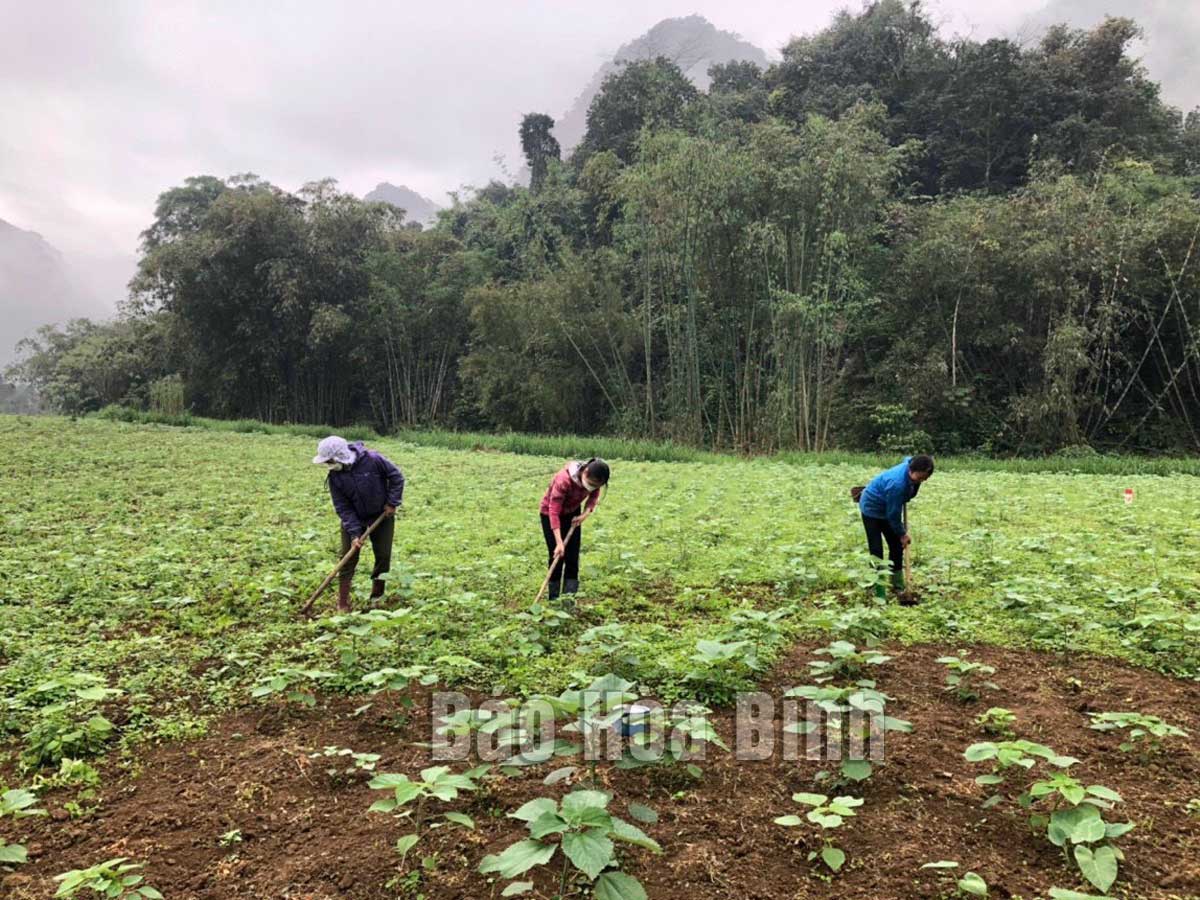
(HBO) – The Hoa Binh Department of Agriculture and Rural Development in collaboration with the An Phuoc Agricultural JSC began a trial planting of ramie (scientific name: Boehmeria Nivea) in some localities in the province in January 2021. After nearly two years, the plant has grown well on the local soil, bringing about incomes for growers.

Farmers in Chieng Chau commune, Mai Chau district, take care of ramie plants.
The main product of ramie, a quite familiar plant in Vietnam, is fiber, which can be used to weave raw fabrics or make ropes and fishing nets. However, it was not until 2021 that the plant was planted in large areas across districts in Hoa Binh.
As of October this year, the total area of ramie in the province neared 260 ha, mainly in upland districts and Hoa Binh city, with 435 households participating in the planting. Da Bac district has the largest plantation of 107 ha, followed by Mai Chau district with 72 ha.
As one of the first to join the trial planting in Bua hamlet, Trung Thanh commune, Da Bac, Luong Van Toan said the plant is relatively easy to cultivate, grows well and quickly for harvest if properly fertilised.
According to the leader of the provincial sub-department of cultivation and plant protection, the average yield of each crop is between 750 and 900 kg of dried bark per ha, creating an income of some 120 - 145 million VND (5,049 – 6,101 USD) per ha on an annual basis. However, this is not the maximum productivity of the plant; higher yields are expected in better cultivation conditions.
An Phuoc plans to expand the current ramie plantation to 300 hectares in 2023.
Many households growing the plant said that the initial investment cost is quite high, at about 40 million VND per ha. For sustainable and long-term growth, it is necessary to have a bark processing facility in the area and a commitment from enterprises involved to ensure long-term planting areas, they said.
Echoing the view, Nguyen Duc Bien, Vice Chairman of the provincial Farmers' Association, said that before scaling up and mass planting, it is necessary to conduct research and carefully evaluate the economic efficiency of the plant./.
Hoa Binh province is undergoing a dynamic transformation amid Vietnam’s national digital transition. Building on Poliburo’s Resolution No. 57-NQ/TW on breakthroughs in science, technology, innovation, and national digital transformation, the province has rolled out a wide range of practical action plans. A standout initiative is the "Digital Literacy for All” movement, an effort to ensure that no one is left behind in the digital era.
Hoa Binh province is undergoing a dynamic transformation in the wake of the national digital transformation movement. Building on Resolution No. 57-NQ/TW of the Politburo on breakthroughs in science, technology, innovation, and national digital transformation, the province has implemented a wide range of practical action plans. A standout initiative is the "Digital Literacy for All” movement ambitious effort to ensure that no one is left behind in the digital age.
With a spirit of unity and proactive problem-solving, the Party Committee, the government and the people of Dong Lai Commune (Tan Lac District) have made great strides in implementing the resolutions of the 24th Party Congress of the commune for the 2020 - 2025 term. Focusing on leadership and practical actions, the commune has brought the Party’s resolutions into daily life, creating strong impacts and pushing the local development forward.
Amid the nationwide push for digital transformation, young people in Hoa Binh Province are stepping up as dynamic pioneers, applying technology to enhance Youth Union operations and expand the reach of youth-led initiatives. Through creativity and adaptability, Youth Union organizations at all levels have introduced a series of practical solutions, contributing to modern governance and community development.
In recent years, An Nghia commune, located in Lac Son district, has stepped up administrative reform, focusing on improving the quality and efficiency of its single-window service unit for receiving and processing administrative procedures. These improvements have helped create favourable conditions for local residents and organisations to handle administrative procedures, contributing to the commune’s broader socio-economic development.
The Prime Minister-approved master plan to develop the multi-use value of forests ecosystems through 2030, with a vision to 2050, aims to improve the management and sustainable use of forest resources, create jobs, increase incomes, and improve the living standards of ethnic minorities, people in mountainous and remote areas, forest workers and those living near forests.



